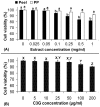Inhibition of oxidative stress and lipid peroxidation by anthocyanins from defatted Canarium odontophyllum pericarp and peel using in vitro bioassays
- PMID: 24416130
- PMCID: PMC3886967
- DOI: 10.1371/journal.pone.0081447
Inhibition of oxidative stress and lipid peroxidation by anthocyanins from defatted Canarium odontophyllum pericarp and peel using in vitro bioassays
Abstract
Canarium odontophyllum, also known as CO, is a highly nutritious fruit. Defatted parts of CO fruit are potent sources of nutraceutical. This study aimed to determine oxidative stress and lipid peroxidation effects of defatted CO pericarp and peel extracts using in vitro bioassays. Cell cytotoxic effect of the CO pericarp and peel extracts were also evaluated using HUVEC and Chang liver cell lines. The crude extracts of defatted CO peel and pericarp showed cytoprotective effects in t-BHP and 40% methanol-induced cell death. The crude extracts also showed no toxic effect to Chang liver cell line. Using CD36 ELISA, NAD(+) and LDL inhibition assays, inhibition of oxidative stress were found higher in the crude extract of defatted CO peel compared to the pericarp extract. Hemoglobin and LDL oxidation assays revealed both crude extracts had significantly reduced lipid peroxidation as compared to control. TBARS values among defatted CO pericarp, peel, and cyanidin-3-glucoside showed no significant differences for hemoglobin and LDL oxidation assays. The protective effects of defatted CO parts, especially its peel is related to the presence of high anthocyanin that potentially offers as a pharmaceutical ingredient for cardioprotection.
Conflict of interest statement
Figures








References
-
- Rice-Evans CA, Miller NJ, Paganga G (1996) Structure-antioxidant activity relationships of flavonoids and phenolic acids. Free Radic Biol Med 20: 933–956. - PubMed
-
- Azlan A, Nasir NNM, Amom Z, Ismail A (2009) Physical properties of skin, flesh, and kernel of Canarium odontophyllum fruit. J Food Agric Environ 7: 55–57.
-
- Azlan A, Prasad KN, Khoo HE, Abdul-Aziz N, Mohamad A, et al. (2010) Comparison of fatty acids, vitamin E and physicochemical properties of Canarium odontophyllum Miq. (dabai), olive and palm oils. J Food Compos Anal 23: 772–776.
-
- Chew LY, Prasad KN, Amin I, Azrina A, Lau CY (2011) Nutritional composition and antioxidant properties of Canarium odontophyllum Miq. (dabai) fruits. J Food Compos Anal 24: 670–677.
-
- Chew LY, Khoo HE, Amin I, Azrina A, Lau CY (2012) Analysis of phenolic compounds of dabai (Canarium odontophyllum Miq.) fruits by high-performance liquid chromatography. Food Anal Methods 5: 126–137.
Publication types
MeSH terms
Substances
LinkOut - more resources
Full Text Sources
Other Literature Sources

